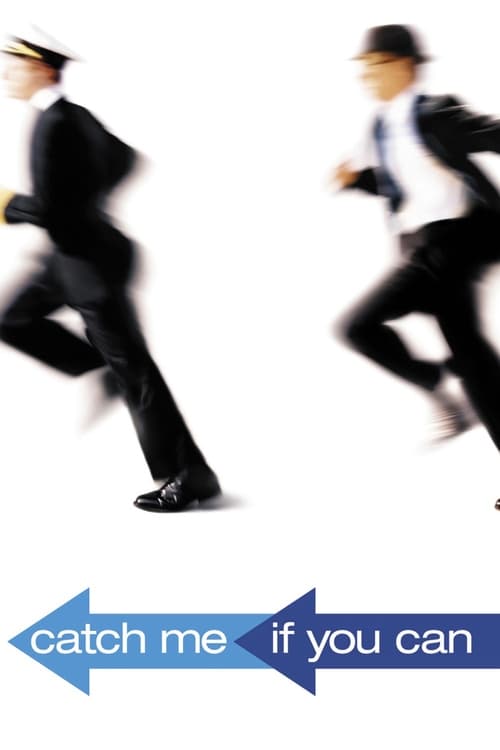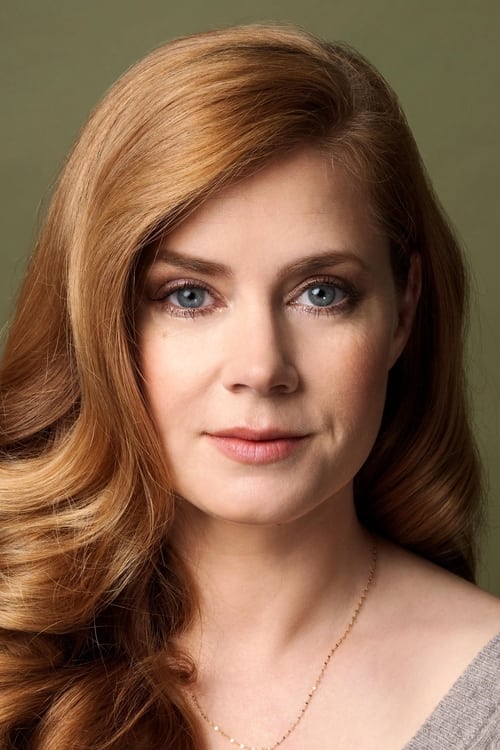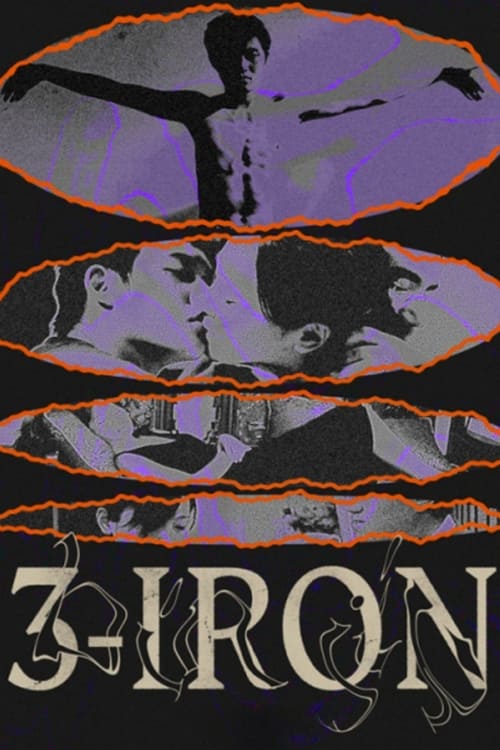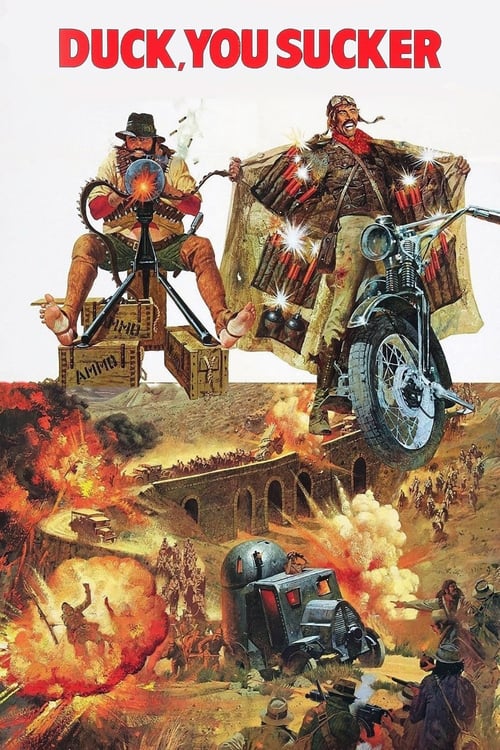
Catch Me If You Can
A true story about Frank Abagnale Jr. who, before his 19th birthday, successfully conned millions of dollars worth of checks as a Pan Am pilot, doctor, and legal prosecutor. An FBI agent makes it his mission to put him behind bars. But Frank not only eludes capture, he revels in the pursuit.
Dialogues from Movie Catch Me If You Can
Quotes from Movie Catch Me If You Can
Sound Tracks from Catch Me If You Can by John Williams
River Peak
River Peak by John Williams, Main theme throughout the film
Complainte de la Butte
Complainte de la Butte by Georges Auric, Played during the Paris scene
Summer Wind
Summer Wind by Frank Sinatra, Played during the romantic scenes between Frank and Brenda
All the Way
All the Way by Frank Sinatra, Played during the closing credits
The Girl from Ipanema
The Girl from Ipanema by Astrud Gilberto, Played in the background during a scene set in a hotel
Download App
Memorable Scenes from Movie Catch Me If You Can
The Con Game Begins
Frank Abagnale Jr., a young con artist, begins to master the art of deception. The build-up shows his challenging family background, especially the tumultuous relationship with his father. His motivations stem from wanting to escape his mundane life and make money quickly. The pivotal moment comes when he successfully poses as a Pan Am pilot, tricking everyone into believing he is a seasoned airline captain. His polished fake persona shines through as he confidently walks through the airport, drawing gasps from onlookers. The aftermath demonstrates how this moment sets him on a path filled with adventure and crime but also foreshadows the loneliness and danger he will face. This scene evokes feelings of excitement and intrigue, as viewers are pulled into Frank's world of lies and thrills. It stands out because it marks the beginning of an extraordinary journey, blending charm and risk in equal measure.
Context: This is a key moment where we see Frank's transformation from an ordinary teenager to a skilled con artist, highlighting both his cleverness and the consequences of his choices.
The Parental Disconnect
In a poignant flashback, Frank watches as his parents' marriage collapses. The build-up hints at his strong desire for a stable home life, which is shattered by their constant fighting. The pivotal moment occurs when his father loses their house in front of Frank, prompting him to run away, feeling lost and abandoned. The emotional weight of the scene is heavy, as the visuals show Frank tearing up, signifying his pain. The aftermath reveals how this familial breakdown pushes him into the world of crime as he seeks independence and validation elsewhere. This scene elicits feelings of sadness and empathy, as viewers witness the root of Frank's struggles. It remains memorable since it humanizes him, offering insight into the emotional foundation of his con artist persona.
Context: This moment deepens the understanding of Frank's motivations and illustrates the stark contrast between his yearning for connection and the reality of his fractured family.
Meeting Carl Hanratty
Frank's cat-and-mouse game begins when FBI agent Carl Hanratty becomes deeply interested in capturing him. The build-up emphasizes Carl's tenacity, as he has dedicated his professional life to apprehending con artists. The pivotal moment happens when Carl finally catches up to Frank in a hotel room; they share a tense conversation. The visual tension escalates, with close-ups showing Frank's cocky grin contrasting with Carl's determined gaze. This moment is crucial as it sets the tone for their complex relationship—both adversaries and, in some ways, reluctant allies. The aftermath is influential as it solidifies Carl's obsession with Frank, turning their pursuit into a personal vendetta. This scene sparks a feeling of suspense and eventual camaraderie, showcasing how their dynamic evolves throughout the film. It's significant because it introduces a key player in Frank's life who understands him better than most.
Context: Here, viewers grasp the clash of two worlds—Frank's playful deceit and Carl’s relentless dedication to the law, highlighting the film's themes of confrontation and wit.
The Emotional Reunion
In a touching moment, Frank reunites with his estranged father toward the end of the film. The build-up reveals a bittersweet sentiment as Frank's life has been a tumultuous ride, marked by his longing for familial connection. The pivotal moment comes when Frank’s father expresses pride in his son despite his criminal lifestyle, conveying unconditional love. The visuals of the two embracing emphasize the gravity of the moment. The aftermath sees Frank grappling with his identity, torn between the man he has become and the child yearning for approval. The emotions surge, mixing joy with heart-wrenching sadness as viewers reflect on family bonds. This scene leaves a profound impact, cementing the idea that no matter how far one strays, the ties of family remain strong and impactful.
Context: This reunion encapsulates the film's exploration of identity, acceptance, and the complexity of familial relationships, revealing Frank’s vulnerability at his core.
The Chase
As Carl finally corners Frank in the airport, the chase unfolds with high stakes and urgency. The build-up showcases the tension, with both characters aware that this is the climax of their cat-and-mouse game. The pivotal moment occurs when Frank ducks into a crowd, showcasing his quick thinking, while Carl rushes to follow him. Fast-paced editing, coupled with an adrenaline-pumping score, creates a thrill that captivates the audience. The aftermath of this chase is critical as it reinforces Frank's cleverness and resourcefulness, but also reveals Carl's relentless pursuit. Viewers feel a rush of excitement and anxiety, rooting for Frank's escape while acknowledging the moral complexity of his character. This scene is a testament to the film's blend of humor and tension, emphasizing the chase as a metaphor for freedom and imprisonment.
Context: This scene captures the essence of their relationship—it’s not just a physical chase, but an ongoing battle of wills, representing deeper themes of pursuit and escape.
The Final Con
In a deeply strategic moment, Frank stages one last massive con, posing as a doctor in a hospital. The build-up emphasizes his determination to outsmart the authorities and escape his legal troubles. The pivotal moment presents itself when he efficiently treats a patient, showcasing both his charm and quick wit, even while risking his freedom. The visuals of the bustling hospital juxtaposed with Frank's calm demeanor heighten the tension. The aftermath sees Frank almost getting away with it, but it all crumbles when Carl arrives. This evokes a sense of thrill and fear; viewers witness Frank's brilliance and the precariousness of his situation. This scene highlights the fine line between success and failure in Frank's life, showcasing how one moment can alter everything.
Context: This last con reflects Frank's continuous chase for acceptance and success, illustrating how deeply his need for validation drives him, even to the point of peril.
The Revelation
Amidst the chaos, Carl finally learns the truth behind Frank's motivations through their conversations and the glimpses of Frank's background. The buildup hints at Carl starting to see Frank not just as a criminal but as a person shaped by circumstances. The pivotal moment occurs when Frank opens up about his dreams and fears, cementing their bond as he shares his pain of abandonment. The heartfelt dialogue, marked by vulnerability, reveals the complexity of Frank’s character, who reflects on his choices. This moment changes Carl’s perception, fueling his determination to help Frank rather than simply catch him. Viewers experience compassion and understanding, realizing that behind the façade of the con man lies a young boy desperate for love. This scene resonates because it highlights themes of empathy and the human condition.
Context: Carl's realization deepens the narrative, showcasing how understanding someone’s struggle can transcend the label of 'criminal,' adding layers to both characters.
The First Escape
In a thrilling opening sequence, Frank successfully escapes from a moving train, using his wit and courage. The buildup shows his mounting desperation as he anticipates being caught by Carl. The pivotal moment is when he jumps from the train, symbolizing a leap towards freedom and uncertainty. The adrenaline rush of the visuals, paired with heart-pounding sound design, captures the daring nature of the action. The aftermath reveals Frank’s agility in evading capture, further affirming his resourcefulness. Viewers feel a rush of exhilaration and awe, rooting for Frank as he defies the odds. This scene perfectly encapsulates the film’s themes of escape and transformation, and it becomes a defining moment in establishing Frank's character.
Context: This escape marks Frank’s boldness, showcasing how his survival instincts kick in, right from the start, preparing viewers for the thrilling exploits to come.
The Engagement
Frank falls in love with Brenda, the daughter of a doctor he impersonates, marking a pivotal shift in his life. The build-up shows Frank’s initial charm and romantic gestures, making their connection feel genuine, though built on deception. The pivotal moment comes during a heartfelt dinner scene, where Frank sees Brenda's dreams and aspirations, reflecting his desire for a normal life. The warm lighting and intimate framing of their interactions create a sense of safety and belonging. The aftermath reveals Frank's internal conflict as he realizes he genuinely cares for Brenda, complicating his life of lies. This elicits feelings of hope and warmth but also concern for the inevitable fall. This scene is significant as it illustrates the clash between Frank's criminal world and the desire for genuine connection, emphasizing love as a powerful force.
Context: This romantic subplot serves as a critical turning point for Frank, exposing his vulnerabilities while underscoring the importance of love and acceptance in shaping personal identity.
The Confrontation
During a heated moment, Frank and Carl confront the reality of their cat-and-mouse chase. The build-up builds tension as both characters lay their cards on the table. The pivotal moment occurs when Carl reveals he’s studied Frank, understand him better than anyone else. The rawness of their dialogue captures the depth of their rivalry and a growing respect. This moment is visually striking, with close-ups displaying their emotional states—Frank’s defiance mixed with a tinge of vulnerability and Carl’s determination. The aftermath highlights the shifting dynamics of their relationship, transforming from adversaries to reluctant allies. Viewers feel a mix of tension and admiration, realizing that both characters are searching for something. This scene stands out for its layer of complexity and emotional intensity, highlighting the human element in their struggle.
Context: The confrontation sheds light on Frank’s inner turmoil and Carl’s own motivations, mirroring the film's exploration of the fine line between the law and personal ethics.
The Chase through the Streets
A frantic chase sequence through crowded streets signifies another high point of tension between Frank and Carl. The build-up showcases Frank’s heightened sense of urgency, knowing he’s being cornered. The pivotal moment peaks as Frank ducks into a busy department store, trying to lose Carl in a sea of shoppers. The rapid cuts and swift camera movements convey the chaos and adrenaline of the moment. The aftermath reveals that while Frank momentarily escapes, it emphasizes the futility of running from one’s past and choices. Viewers feel breathless and engaged, witnessing the relentless pursuit that keeps them on the edge of their seats. This scene's significance lies in its representation of Frank’s pursuit of freedom while illustrating the inescapability of one’s actions.
Context: These chase scenes are not merely for thrill; they echo Frank’s ongoing struggle with his conscience and the reality that he cannot outrun his mistakes.
The Final Capture
In a heartbreaking moment, Frank is ultimately caught by Carl after a long spree of deception. The build-up illustrates Frank's growing paranoia as he realizes the noose is tightening around him. The pivotal moment reflects the stark realization as Carl boldly intercepts him in an airport. The visuals depict Frank’s shocked expression contrasted with Carl’s determined demeanor, creating a poignant tension. The aftermath reveals the emotional fallout of this moment as Frank is led away in handcuffs, marking a shift from freedom to confinement. Viewers feel a wave of disappointment and disbelief, as the excitement of his escapades comes to a crashing halt. This scene underscores the film's themes of consequence and character redemption, portraying the harsh truth behind a life of crime.
Context: This moment signifies the end of Frank’s thrilling escapades and the beginning of a reckoning, encapsulating the ultimate realization of one’s actions.
The Truth Unveiled
Towards the resolution, Frank confesses to Brenda the truth of who he really is. The build-up stresses the weight of his lies and the longing for honesty in their relationship. The pivotal moment centers on his heartfelt admission, where Frank acknowledges his deception and the hurt it may cause. The visuals are intimate, focusing on their faces to capture the emotional exchange. After Frank’s confession, Brenda experiences a mix of emotions that reflect heartache and disillusionment. This moment resonates deeply with viewers, creating a sense of empathy for both characters. The scene stands out because it reveals the human cost of deception and the fragility of love, emphasizing honesty as a crucial element in relationships.
Context: This moment emphasizes the central theme of truth versus lies, serving as a reminder of the complex nature of love and trust.
Confronting the Law
In a reflective moment, Frank sits in a holding cell, pondering his choices. The buildup shows him mentally revisiting key moments of his life, from the joy of success to the agony of betrayal. The pivotal realization occurs when he acknowledges that his life of crime has caused more damage than good. The somber visuals present Frank in a stark, cold environment, contrasting with the vibrant life he once led. The aftermath highlights his internal struggle, marking the beginning of his desire for redemption. This evokes sadness and contemplation, as viewers feel for a character who is coming to terms with the consequences of his actions. This scene is significant as it captures the journey towards understanding and accepting one’s mistakes.
Context: This moment symbolizes the turning point in Frank's character arc, as he begins to embrace accountability, setting the stage for his eventual redemption.
Frank and Carl’s Bond
In a moment of vulnerability, Carl shares a personal story with Frank while they are both on the run. The buildup shows the unlikely bond that has formed between them, driven by mutual respect and understanding. The pivotal moment occurs when Carl divulges his own feelings of isolation in his job, making Frank realize they are more alike than different. This visually intimate exchange fosters a bond of trust, showcasing the emotional depth of their connection. The aftermath leads to a partnership of sorts, complicating their relationship dynamic further. Audiences experience a mixture of connection and empathy, as both characters come to terms with their loneliness and desire for understanding. This scene strengthens the thematic exploration of companionship amidst a tumultuous journey.
Context: This moment highlights how shared experiences can forge unexpected bonds, adding depth to both characters within the larger narrative.
The Transformation Begins
At one point, Frank starts to help the FBI with catching other criminals showcasing a shift in his character. The build-up illustrates Carl’s influence on Frank, leading him to understand the importance of using his talents for good. The pivotal moment strikes when Frank successfully assists in a con operation to catch a gang, marking a turning point in his life. The visuals capture Frank’s mix of trepidation and excitement as he uses his skills for justice. The aftermath reveals his evolving character and the potential for redemption. This scene evokes feelings of hope and inspiration, as viewers see Frank embrace a new purpose. This transformation showcases the central theme of redemption and the idea that every individual has the capacity for change.
Context: This moment emphasizes the possibility of growth and change, underlining the idea that even those who stray can find a path to redemption.
The Legacy of Deception
In a bittersweet final scene, Frank reflects on his life choices during a quiet moment in prison. The buildup emphasizes his journey of realization and acceptance of his past. The pivotal moment occurs when he acknowledges that his ability to deceive once hurt others but can now help him rebuild his life. The visual focus on Frank’s contemplative expression highlights his growth. The aftermath delves into the theme of legacy as Frank resolves to use his skills positively. This evokes a mix of nostalgia and hope, as viewers appreciate his complex journey. This scene resonates because it highlights the possibility of transformation and leaving a legacy that is both redemption and growth.
Context: This moment encapsulates the film’s overarching message about finding purpose beyond past mistakes, reinforcing the theme of self-discovery and acceptance.
Facing Reality
In a climactic moment, Frank is forced to submit to his reality while facing Carl in court. The buildup leads to an emotional confrontation where Frank must reckon with the consequences of his actions. The pivotal moment occurs when Carl, instead of reveling in Frank’s downfall, offers him a chance at redemption. The visuals, marked by intense close-ups, convey the emotional weight of their exchange. The aftermath sets the stage for Frank’s potential reformation. Viewers experience a mix of relief and tension, recognizing that there still exists hope for Frank. This scene underscores the film's themes of justice, redemption, and the complexity of human relationships.
Context: Here, the relationship between Frank and Carl evolves further, mirroring the film's exploration of forgiveness and the possibility of second chances.
The Last Goodbye
In a farewell moment, Frank bids goodbye to his false identity, symbolizing acceptance of his new life. The buildup shows his internal struggle as he reflects on the thrilling escapades and personal cost. The pivotal moment comes when Frank stands at a crossroads, choosing to embrace honesty. The visuals, with warm lighting and soft focus, capture his relief and resolve. The aftermath showcases Frank’s readiness to face the future with integrity. This evokes a sense of catharsis, as viewers recognize the impactful journey he has traversed. This scene is memorable because it solidifies the theme of self-acceptance and the importance of personal growth.
Context: This moment emphasizes Frank's journey towards understanding the power of truth, encapsulating the film's message about the consequences of deception.
Download App








